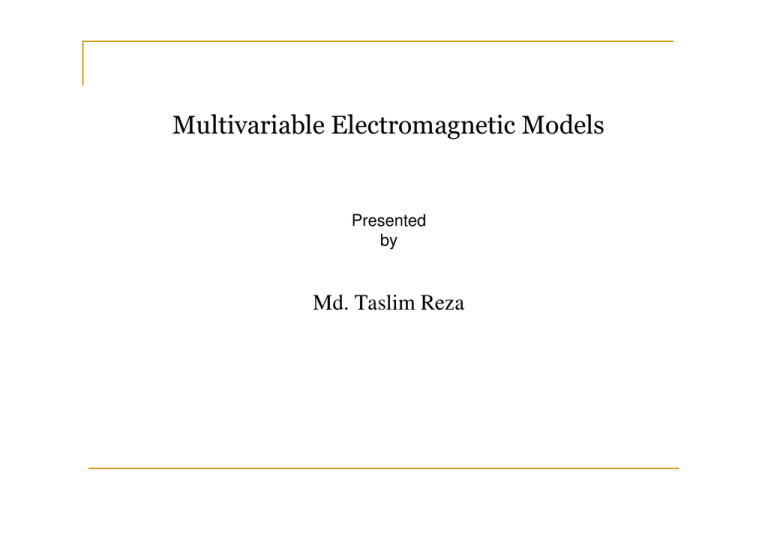forced response
advertisement

Presented by Md. Taslim Reza Modeling RLC circuit by using differential (second-order) equation and to determine the complete response out of it. There are a number of steps involved in determining the complete response: Obtaining the differential equations of the circuit Determining the resonant frequency and the damping ratio Obtaining the characteristic equations of the circuit Finding the roots of the characteristic equation Finding the natural response Finding the forced response Finding the complete response The direct method: The most direct method for finding the differential equations of a circuit is to perform a nodal analysis, or a mesh current analysis on the circuit, and then solve the equation for the input function. The final equation should only contain derivatives, no integrals. The variable method: If we create 2 variables, g and h, we can use them to create a second-order differential equation. First, we set g and h to be either inductor currents, capacitor voltages, or both. Next, we create a single first order differential equation that has g = f(g, h). Then, we write another first-order differential equation that has the form: Next, we substitute in our second equation into our first equation, and we have a second-order equation. Characteristic Equation: The characteristic equation of an RLC circuit is obtained using the "Operator Method" described below, with zero input. The characteristic equation of an RLC circuit (series or parallel) will be: The roots to the characteristic equation are the "solutions" that we are looking for. This method of obtaining the characteristic equation requires a little trickery. First, we create an operator s such that: Also, we can show higher-order operators as such: Where x is the voltage (in a series circuit) or the current (in a parellel circuit) of the circuit source. We write 2 first order differential equations for the inductor currents and/or the capacitor voltages in our circuit. We convert all the differentiations to s, and all the integrations (if any) into (1/s). We can then use Cramer's rule to solve for a solution. The differential equation to a simple series circuit with a voltage source V, and a resistor R, a capacitor C, and an inductor L is: Where vs is the voltage from the source, and v is the voltage over the capacitor. This provides us with a characteristic equation of: Or, in other words: where o = resonant frequency and = damping ratio The differential equation to a parallel RLC circuit with a current source I, a resistor R, a capacitor C, and an inductor L is as follows: Where is is the source current, and i is the current flowing through the inductor. The characteristic equation then, is as follows: Or, in other words: where o = resonant frequency and = damping ratio Once we have our differential equations, and our characteristic equations, we are ready to assemble the mathematical form of our circuit response. RLC Circuits have differential equations in the form: Where f(t) is the forcing function of the RLC circuit. The natural response of a circuit is the response of a given circuit to zero input (i.e. depending only upon the initial condition values). The natural Response to a circuit will be denoted as xn(t). The natural response of the system must satisfy the unforced differential equation of the circuit: We now define the natural response to be an exponential function: xn = A1est + A2est Where s are the roots of the characteristic equation of the circuit. The reasons for choosing this specific solution for xn is based in differential equations theory, and we will just accept it without proof for the time being. We can solve for the constant values, by using a system of two equations: x(0) = A1 + A2 Where x is the voltage (of the elements in a parallel circuit) or the current (through the elements in a series circuit) The forced response of a circuit is the way the circuit responds to an input forcing function. The Forced response is denoted as f(t). Where the forced response must satisfy the forced differential equation: The forced response is based on the input function, so we can't give a general solution to it. However, we can provide a set of solutions for different inputs: Input Form K (constant) Msin( t) Me − at Output Form A (constant) Asin( t) + Bcos( t) Ae − at The Complete response of a circuit is the sum of the forced response, and the natural response of the system: xc(t) = xt(t) + xs(t) Once we have derived the complete response of the circuit, we can say that we have "solved" the circuit, and are finished working. References: [1] http://en.wikibooks.org/wiki/Circuit_Theory/Second-Order_Solution [2] http://circuitscan.homestead.com/files/idxpages.htm [3] http://www.math.ubc.ca/~feldman/m121/RLC.pdf !" $ %& # '



